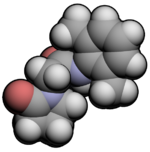Nefiracetam is a nootropic drug of the racetam family. Preliminary research suggests that it may possess certain antidementia properties in rats.[2]
 | |
 | |
| Clinical data | |
|---|---|
| Routes of administration | Oral |
| ATC code |
|
| Legal status | |
| Legal status |
|
| Pharmacokinetic data | |
| Elimination half-life | 3-5 hours[1] |
| Identifiers | |
| |
| CAS Number | |
| PubChem CID | |
| ChemSpider | |
| UNII | |
| ChEMBL | |
| CompTox Dashboard (EPA) | |
| ECHA InfoCard | 100.163.910 |
| Chemical and physical data | |
| Formula | C14H18N2O2 |
| Molar mass | 246.310 g·mol−1 |
| 3D model (JSmol) | |
| |
| |
| | |
Effects
editNefiracetam's cytoprotective actions are mediated by enhancement of GABAergic, cholinergic, and monoaminergic neuronal systems.[citation needed] Preliminary studies suggest that it improves apathy and motivation in post-stroke patients. It may also exhibit antiamnesia effects for the Alzheimer's type and cerebrovascular type of dementia.[3][4] In addition, research in animal models suggests antiamnesic effects against a number of memory impairing substances, including: ethanol, chlorodiazepoxide, scopolamine, bicuculline, picrotoxin, and cycloheximide.[5]
Pharmacology
editUnlike other racetams, nefiracetam shows high affinity for the GABAA receptor (IC50) = 8.5 nM), where it is presumed to be an agonist.[6][7] It was able to potently inhibit 80% of muscimol binding to the GABAA receptor, although it failed to displace the remaining 20% of specific muscimol binding.[6][7] Nefiracetam is able to reverse the amnesia caused by the GABAA receptor antagonists picrotoxin and bicuculline in mice, although it failed to prevent seizures induced by these drugs.[7]
Concerns
editStudies of long-term consumption of nefiracetam in humans and primates have shown it to have no toxicity.[8][9] However, animals which metabolize nefiracetam differently from humans and primates are at risk for renal and testicular[10][11] toxicity. Dogs especially are particularly sensitive, which has been shown to be caused by a specific metabolite, M-18 which isn't formed in humans.[12] Higher doses than those in dogs were needed to cause testicular toxicity in rats, although no toxicity was seen in monkeys. Additionally, there has been no evidence of toxicity during clinical trials.[8][9]
See also
editReferences
edit- ^ Fujimaki Y, Sudo K, Hakusui H, Tachizawa H, Murasaki M (September 1992). "Single- and multiple-dose pharmacokinetics of nefiracetam, a new nootropic agent, in healthy volunteers". The Journal of Pharmacy and Pharmacology. 44 (9): 750–754. doi:10.1111/j.2042-7158.1992.tb05513.x. PMID 1360528. S2CID 25913554.
- ^ Murphy KJ, Foley AG, O'connell AW, Regan CM (January 2006). "Chronic exposure of rats to cognition enhancing drugs produces a neuroplastic response identical to that obtained by complex environment rearing". Neuropsychopharmacology. 31 (1): 90–100. doi:10.1038/sj.npp.1300810. PMID 15988469.
- ^ Robinson RG, Jorge RE, Clarence-Smith K, Starkstein S (2009). "Double-blind treatment of apathy in patients with poststroke depression using nefiracetam". The Journal of Neuropsychiatry and Clinical Neurosciences. 21 (2): 144–151. doi:10.1176/appi.neuropsych.21.2.144. PMID 19622685.
- ^ Robinson RG, Jorge RE, Clarence-Smith K (2008). "Double-blind randomized treatment of poststroke depression using nefiracetam". The Journal of Neuropsychiatry and Clinical Neurosciences. 20 (2): 178–184. doi:10.1176/appi.neuropsych.20.2.178. PMID 18451188.
- ^ Hiramatsu M, Shiotani T, Kameyama T, Nabeshima T (February 1997). "Effects of nefiracetam on amnesia animal models with neuronal dysfunctions". Behavioural Brain Research. 83 (1–2): 107–115. doi:10.1016/s0166-4328(97)86053-6. PMID 9062668. S2CID 4045550.
- ^ a b Gouliaev AH, Senning A (May 1994). "Piracetam and other structurally related nootropics". Brain Research. Brain Research Reviews. 19 (2): 180–222. doi:10.1016/0165-0173(94)90011-6. PMID 8061686. S2CID 18122566.
- ^ a b c Nabeshima T, Noda Y, Tohyama K, Itoh J, Kameyama T (March 1990). "Effects of DM-9384 in a model of amnesia based on animals with GABAergic neuronal dysfunctions". European Journal of Pharmacology. 178 (2): 143–149. doi:10.1016/0014-2999(90)90469-m. PMID 2328758.
- ^ a b Murasaki M, Inami M, Ishigooka J, Watanabe H, Utsumi M, Matsumoto T, et al. (1994). "Phase I study on DM-9384 (nefiracetam)". Jpn. Pharmacol. Ther. 22: 3539–3587.
- ^ a b Otomo E, Kogure K, Hirai S, Goto F, Hasegawa K, Tazaki Y, et al. (1994). "Clinical evaluation of DM-9384 in the treatment of cerebrovascular disorders: early phase II study". Jpn. Pharmacol. Ther. (22): 3589–3624.
- ^ Shimada M, Shikanai Y, Shimomura K, Harada S, Watanabe G, Taya K, et al. (August 2003). "Investigation of testicular toxicity of nefiracetam, a neurotransmission enhancer, in rats". Toxicology Letters. 143 (3): 307–315. doi:10.1016/s0378-4274(03)00197-8. PMID 12849691.
- ^ Shimomura K, Shimada M, Hagiwara M, Harada S, Kato M, Furuhama K (May 2004). "Testicular toxicity induced in dogs by nefiracetam, a neutrotransmission enhancer". Reproductive Toxicology. 18 (3): 423–430. doi:10.1016/j.reprotox.2004.01.008. PMID 15082078.
- ^ Goto K, Ishii Y, Jindo T, Furuhama K (March 2003). "Effect of nefiracetam, a neurotransmission enhancer, on primary uroepithelial cells of the canine urinary bladder". Toxicological Sciences. 72 (1): 164–170. doi:10.1093/toxsci/kfg010. PMID 12604846.